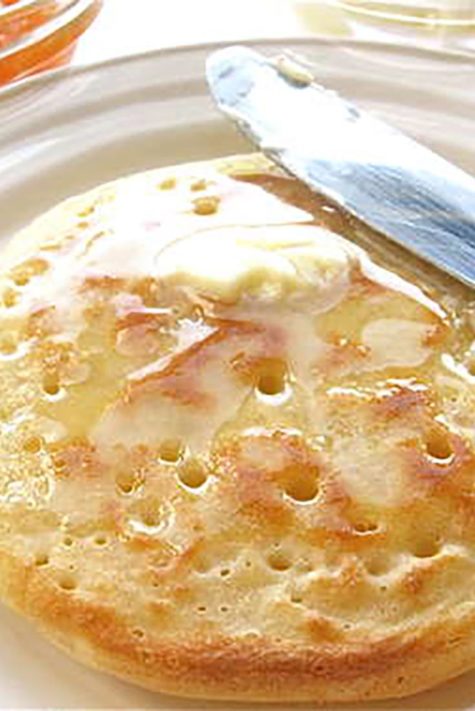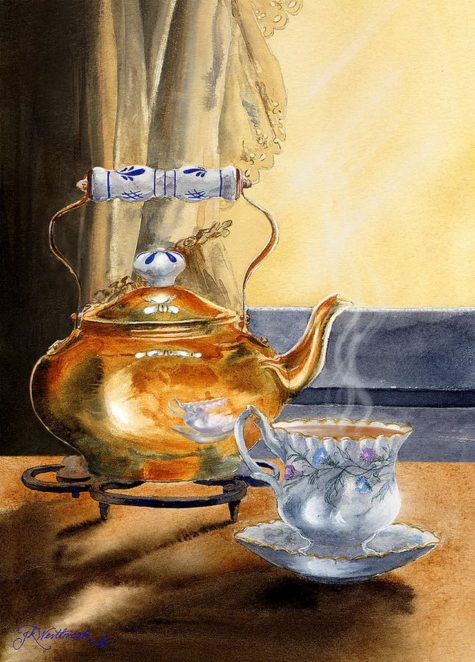Monthly Archives: September 2017
A Crumpet Recipe
What is a crumpet? This traditional British teatime treat is midway between English muffin and pancake. Like an English muffin, it’s full of holes, perfect for collecting rivulets of melted butter. But it’s also moister and thinner – more like a small pancake.
These are best enjoyed toasted, and spread with butter, jam, and/or clotted cream. Since their holes reach to the outside crust, there’s no need to split them before toasting.
You can make crumpets without English muffin rings (or cleaned tuna cans), but they’ll be perfectly round and ever so much nicer looking if you use rings. Here’s a recipe from King Arthur Flour.
A Great Crumpet Recipe
Ingredients:
- 1 1/2 cups lukewarm water
- 1 cup lukewarm milk
- 2 tablespoons melted butter
- 3 1/2 cups Unbleached All-Purpose Flour
- 2 1/2 teaspoons instant yeast
- 1 teaspoon baking powder
- 1 1/4 teaspoons salt
Instructions:
Combine all of the ingredients in a bowl, and beat vigorously for 2 minutes. A stand or hand mixer, set on high speed, work well here.
Cover the bowl, and let the batter rest at room temperature for 1 hour. It will expand and become bubbly. Towards the end of the rest, preheat a griddle to medium-low, about 325°F. If you don’t have an electric griddle, preheat a frying pan; it shouldn’t be as hot as the temperature you use to cook pancakes.
Lightly grease the griddle or frying pan, and place well-greased 3 3/4″ English muffin rings in the pan, as many as will fit. (If you don’t have English muffin rings, use well-cleaned tuna cans, from which you’ve removed the top and bottom.) Pour sticky batter by the scant 1/4-cupful into each ring; a muffin scoop works well here.
After about 4 minutes, use a pair of tongs to slip the rings off. Cook the crumpets for a total of about 10 minutes on the first side, until their tops are riddled with small bubbles/holes. They should be starting to look a bit dry around the edges. Their bottoms will be a mottled, light-golden brown.
Note: They probably won’t be as full of holes as store-bought crumpets; that’s OK.
Turn the crumpets over, and cook for an additional 5 minutes, to finish cooking the insides and to brown the tops gently. This isn’t traditional; “real” crumpets are white on top, but the crumpet police won’t chastise you for adding a little color to the tops.
Remove the crumpets from the pan, and repeat with the remaining batter, until all the crumpets are cooked. Serve warm. Or cool completely, wrap in plastic, and store at room temperature. To enjoy, warm in the toaster. Serve with butter, or butter and jam.
Borrowed from: The Prosperity Project
It’s Tea Time
I think it’s time for a spot of tea!
First up, let’s talk about the tea.
What’s in a tea? Well, hundreds of benefits are hidden within this coloured water that not so many people are particularly fond of. Summer is a great time to take up this wonderful habit, by creating the most appealing iced teas and thus benefiting from their medicinal and restorative powers.
What few of us know is the fact that the word “tea” is correctly used for the following types only:
- Green tea
- Black tea
- White tea
- Oolong tea
- Pu-erh tea
These 5 teas are definitely worth the try. The rest should simply be referred to as infusions. The five kinds are all derived from the Camellia sinensis plant, a shrub native to China and India, and contain unique antioxidants called flavonoids. They all protect against free radicals that can contribute to cancer, heart disease, and clogged arteries. Oolong and black teas are oxidized or fermented, so they have lower concentrations of flavonoids than green tea, but nevertheless their antioxidising power is still high.
Green tea makes you smart and slim
Green tea is supposedly the healthiest beverage on our planet. It contains more than just plain caffeine. Apart from the fact that it produces a response without causing the “jittery” effects associated with too much caffeine, it also has the amino acid L-theanine, which increases the activity of the inhibitory neurotransmitter GABA, which has anti-anxiety effects. It also increases dopamine and the production of alpha waves in the brain.
In other words, these two components mixed together are particularly capable of improving overall brain function.
Apart from making you smart, your drinking at least three cups of green tea a day is recommended to raise the body’s metabolic rate. It is believed that the catechins found in it increase the production of heat within the body, which is related to burning calories. These compounds may inhibit certain chemicals in the brain, thus prolonging this process.
Black tea makes your teeth healthy
Black tea was proved to reduce plaque formation as well as restricting bacteria growth that promotes the formation of cavities and tooth decays. The flavonoids found in black tea kill and surpass cavity bacteria as well as inhibit the growth of bacterial enzymes that form along with that sticky white stuff on our teeth that attracts plaque like a magnet.
White tea keeps your bones healthy
White tea’s antioxidants and anti-aging properties not only protect and help reverse damaged skin, but a regular intake of white tea can improve bone density and strength, and may provide a natural relief from the symptoms of osteoporosis.
Oolong tea makes your skin look healthy and young
According to the Tea Association of the United States, oolong tea falls somewhere between green and black teas, as its leaves are only partially oxidized.
Patients diagnosed with eczema are recommended to drink 3 cups of oolong tea per the day. The beneficial results of oolong tea are likely to be seen in less than a week in these patients. All oolong tea drinkers show remarkable improvement in their skin.
Keep in mind that despite its miraculous effects, oolong tea tends to be very high in caffeine, which is not the healthiest component of this beverage. So if a healthy skin is your aim, try not to exaggerate and drink more than 3 cups a day.
Pu-erh tea is the best hangover cure
In traditional Chinese herbalism, pu-erh tea is considered to open the meridians and warm the spleen and stomach. It helps digestion and cleans your blood. It is often consumed after heavy meals or drunk as a hangover cure or preventative.
The microbial aging of pu-erh tea can result in the production of lovastatin, a natural statin that is used to lower levels of bad cholesterol such as LDL. One study found that the longer this type of tea was aged, the more statin was produced.
So drink up! It is recommended to have a slightly hot cup of tea every time you feel hot, and your body’s temperature will return to its regular value.
How to make a good pot of tea
These are the golden rules:
- Tea loves oxygen – it helps the flavor develop, so always use freshly drawn cold water in the kettle.
- Make sure your pot is clean.
- Warm the pot by swirling a small amount of boiled water in it.
- For black tea, only pour on freshly boiled water and do not over-boil it.
- For green tea, always use the water just at the boil.
- One teaspoon of loose tea per person and one teaspoon for the pot is about right, but add as much or as little to make it to the strength you like.
- Some people believe that sugar masks the flavors in tea. Why not try a fruit tea if you prefer a sweeter taste?
- A tea cosy extends the brewing time and can make the tea bitter and stewed. A removable infuser or teabags can help to get round this problem.
How long should I allow a teabag to brew?
Twinings of London recommends that you allow the teabag to brew for two and a half to three minutes. This allows the flavor to fully develop. Then add milk or lemon or enjoy it black, whatever your preference.
And how long should I allow loose tea to brew?
We recommend that you allow loose tea to brew in a teapot for up to seven minutes. The general rule is: the larger the leaf, the longer the brewing time. Earl Grey and Lady Grey need five minutes, while a smaller leaf tea will only need about four minutes.
Does loose tea make better tea than teabags?
Both have their benefits. For many people, the ritual of preparing loose tea is a pleasure in itself, so this contributes to the enjoyment, while teabags are more convenient. The leaf size is different but the quality in the cup will be the same.
Should the milk go in first or second?
Historically, the ‘milk in first’ rule was to protect the fine bone china it was served in – it’s a very individual thing.
Sometimes I get an oily residue around my cup and on the surface of my tea – what is it?
Because of the small leaf-size in a teabag, the tea can release some essential oils which can sometimes produce a residue. However, this brown residue occurs most often in areas with hard water, so a carbon water filter will reduce this considerably.
How should tea be stored?
Tea absorbs moisture and kitchen smells. To keep your tea fresh and avoid spoiling the flavor, keep loose tea or teabags in a sealed jar or tin.
Borrowed from: The Prosperity Project





